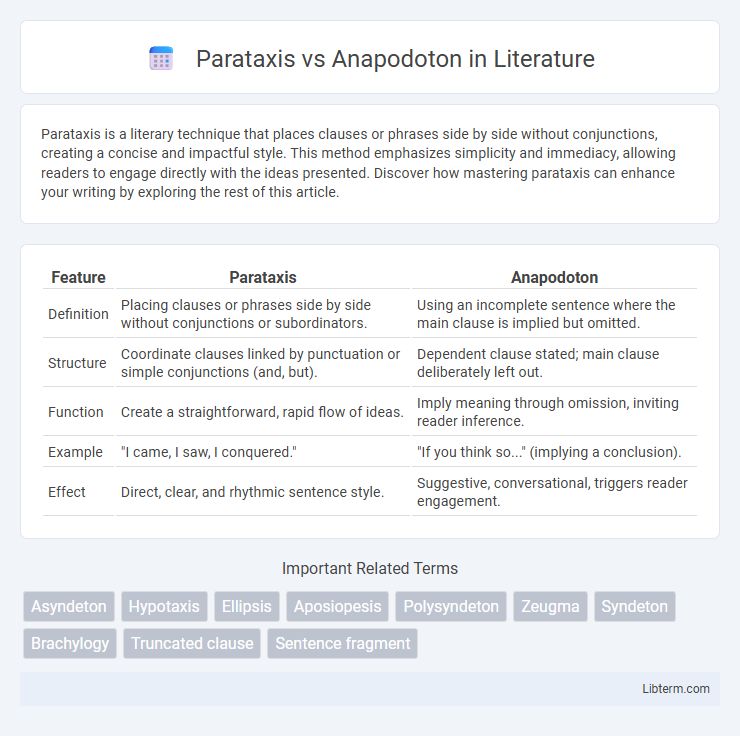Parataxis is a literary technique that places clauses or phrases side by side without conjunctions, creating a concise and impactful style. This method emphasizes simplicity and immediacy, allowing readers to engage directly with the ideas presented. Discover how mastering parataxis can enhance your writing by exploring the rest of this article.
Table of Comparison
| Feature | Parataxis | Anapodoton |
|---|---|---|
| Definition | Placing clauses or phrases side by side without conjunctions or subordinators. | Using an incomplete sentence where the main clause is implied but omitted. |
| Structure | Coordinate clauses linked by punctuation or simple conjunctions (and, but). | Dependent clause stated; main clause deliberately left out. |
| Function | Create a straightforward, rapid flow of ideas. | Imply meaning through omission, inviting reader inference. |
| Example | "I came, I saw, I conquered." | "If you think so..." (implying a conclusion). |
| Effect | Direct, clear, and rhythmic sentence style. | Suggestive, conversational, triggers reader engagement. |
Introduction to Parataxis and Anapodoton
Parataxis involves placing clauses or phrases side by side without using conjunctions, creating a straightforward, staccato rhythm often found in classical rhetoric and modern narratives. Anapodoton refers to an implied or incomplete sentence where the main clause is left unsaid, relying on the audience to infer the missing part, common in everyday speech and literary dialogue. Both techniques shape sentence structure and meaning by manipulating the presence or absence of connectors to influence pacing and emphasis.
Defining Parataxis: Structure and Usage
Parataxis is a syntactic structure characterized by placing phrases or clauses side by side without conjunctions, creating equal emphasis and rhythmic simplicity. Common in both spoken and written language, it enhances clarity and immediacy by linking ideas directly rather than subordinating them. This technique contrasts with anapodoton, which relies on incomplete sentences implying omitted clauses.
Understanding Anapodoton: Meaning and Examples
Anapodoton is a rhetorical device where a main clause is implied but left incomplete, creating an expectation that remains unresolved, often used to evoke emotional or dramatic effects. For example, the phrase "If only he had..." suggests a condition without completing it, prompting the listener to infer the consequence. Understanding anapodoton helps in recognizing how writers and speakers generate emphasis and engage the audience by harnessing implied meanings within incomplete sentences.
Historical Origins of Parataxis
Parataxis originated in ancient Greek rhetoric, prominently used by writers like Homer and Herodotus to present ideas through simple, coordinate phrases without subordinating conjunctions. This style emphasized immediacy and directness, reflecting oral traditions where clarity and rhythm were paramount. Parataxis contrasts with anapodoton, which involves implied or unfinished clauses, highlighting different rhetorical strategies in classical literature.
Historical Development of Anapodoton
Anapodoton, a rhetorical device where a main clause is left incomplete, traces its historical development back to ancient Greek and Roman literature, where it was used for dramatic effect and emphasis. Classical authors like Cicero and Aristotle noted the power of anapodoton in spoken rhetoric for creating suspense and engaging listeners by implying unstated conclusions. Over time, the use of anapodoton evolved through medieval and Renaissance texts, influencing modern linguistic studies and stylistic analysis in both classical and contemporary literature.
Key Differences Between Parataxis and Anapodoton
Parataxis features the placement of clauses or phrases side by side without clear subordination or conjunctions, creating a straightforward and balanced structure, while anapodoton involves an incomplete sentence where the main clause is implied but not expressed, relying on the reader's inference to complete the thought. Parataxis emphasizes equal importance among clauses, enhancing rhythm and immediacy, whereas anapodoton generates suspense or emphasis by leaving the sentence unfinished. These structural differences highlight parataxis's role in syntactic coordination versus anapodoton's function in implied meaning and conversational shorthand.
Literary Examples of Parataxis in Classic Texts
Parataxis is exemplified in classic texts like Hemingway's "A Farewell to Arms," where simple, short sentences are placed side by side without conjunctions, creating a straightforward, urgent rhythm. Similarly, in the Old Testament, phrases such as "the mountains skipped like rams, the hills like lambs" demonstrate paratactic structure by listing vivid images without subordinate clauses. This technique enhances clarity and immediacy, reflecting the authors' stylistic intent to convey directness and emotional intensity.
Notable Uses of Anapodoton in Literature
Notable uses of anapodoton in literature are found in works by Shakespeare and modernist poets, where incomplete sentences create suspense and emphasize emotional turmoil. This rhetorical device often appears in dialogue and stream-of-consciousness writing, enhancing the natural flow and mimicking spoken language. Anapodoton heightens ambiguity, inviting readers to infer meaning and engage actively with the text.
Effects on Readers: Parataxis vs. Anapodoton
Parataxis creates a rhythmic and fast-paced effect by placing clauses or phrases side by side without conjunctions, making the text feel direct and impactful. Anapodoton engages readers through implied meaning, as incomplete sentences provoke curiosity and invite mental completion, fostering active participation. Both techniques influence reader perception, with parataxis emphasizing immediacy and urgency, while anapodoton encourages interpretive involvement.
Choosing Between Parataxis and Anapodoton in Writing
Choosing between parataxis and anapodoton in writing depends on the desired rhythm and impact; parataxis employs straightforward, coordinate clauses to create a brisk, direct style, while anapodoton uses incomplete sentences or ellipsis to engage readers by implying missing information. Parataxis suits narratives requiring clarity and momentum, whereas anapodoton enhances emphasis or conversational tone by inviting inference. Writers should evaluate context, audience, and pacing to determine whether a concise, cumulative effect or suggestive, elliptical construction best serves their message.
Parataxis Infographic

 libterm.com
libterm.com